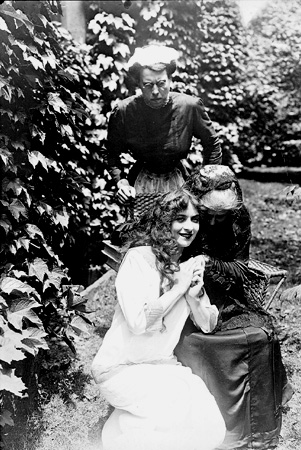 Volume II: Filmography
Volume II: Filmography Volume II: Filmography
Volume II: Filmography

Production still with Maude Fealy. Courtesy of Dominick Bruzzese. (F-605)
(Mutual)
September 1913
Length: 4 reels
Character: Drama
Director: Lawrence Marston
Scenario: Lloyd F. Lonergan from a story of the same title by Ouida (nom de plume of Maria Louise de la Ramée)
Cameraman: Carl Louis Gregory
Cast: Maude Fealy (leading lady), William Russell (leading man), Harry Benham (Correze), Gerda Holmes, Mrs. Lawrence Marston, Lila Chester (Lady Dolly), James Cruze (villain), Riley Chamberlin
Music: Orchestration arranged by E.A. Price and other musicians at the Tams Music Library, New York City
Notes: 1. This film was produced by Thanhouser and distributed as a special Mutual Film Corporation release in the month of September, without a specific day release date. It was not listed as part of the regular Thanhouser schedule. 2. Moths was extensively advertised for many months in the various trade publications, including two-color, full-page notices in Reel Life. No release date was ever mentioned. 3. Harry Benham's role was listed as Carrezzi in some notices. 4. Music scores were available for this film, but they were not widely advertised. Later, beginning with The Legend of Provence (released December 1, 1913), the availability of music scores was featured extensively in advertising. 5. An expanded story by Robert Hage, based on the film, appeared in The Photoplay Magazine, November 1913. No standard American motion picture trade journal carried a synopsis of the film.
BACKGROUND OF THE SCENARIO: Moths was from the pen of Ouida, nom de plume of Marie Louise de la Ramée (or Ramé) (January 1, 1839-January 25, 1908), whose biography can be found in the present work under the entry for Under Two Flags (released July 7, 1912). Moths, issued in 1880, was popular through the early 20th century and was undoubtedly familiar in advance to many who saw the Thanhouser film. Also dramatized for the screen by Thanhouser were two other Ouida stories: A Dog of Flanders, a children's story, and one of several tales Ouida wrote about animals, first published in 1872, and released as a film by Thanhouser on May 19, 1914; and Under Two Flags, an 1867 story, released as a film by Thanhouser on July 7, 1912.
SYNOPSIS-REVIEW, The Bioscope, October 16, 1913:
"There is much in Ouida's celebrated novel which lends itself admirably to adaptation for the film, and the Thanhouser Company has condensed it in a way which follows the book closely in its main features, and gives occasion for some very effective stage pictures. The opening scenes show Vere at the home of her guardian, the Duchess of Mull, who thinks, however, that the girl ought to see more of her mother, Lady Dolly Vanderdecken, and writes suggesting that Vere should join her in Paris. This arrangement is by no means to Lady Dolly's taste, who prefers to spend her life unhampered by the company of an exceedingly attractive daughter. She therefore decides to marry Vere to Prince Zouroff. But Vere is not attracted by his personality or his somewhat notorious reputation, particularly after meeting the eminent tenor, Correze, who sees her paddling, and rescues her at serious risk to his shoes and stockings.
"After trying threats and entreaties in vain, Lady Dolly at last persuades Vere to accept the prince by pretending that he has it in his power to ruin her if he is refused. The marriage takes place, but Vere soon discovers that her husband is an abandoned profligate, who has so little respect for his wife as to introduce women to his house to whom he is openly making love. Vere's refusal to submit to this treatment decides the Prince to banish her to his estates in Poland, telling her that she shall only return to Paris on the condition that she consents to receive his friends. Zouroff returns to Paris, and, meeting Correze at a reception, he insults him publicly. A duel is arranged, and Correze is seriously wounded. He recovers, however, and learns that Vere has succeeded in obtaining a divorce. He hastens to her, and nothing further stands in the way of their future happiness. There is very little action in the play, and it is somewhat unduly drawn out by the very deliberate methods of the company, who all seem to play too slowly. The setting is elaborate and sumptuous, and many of the scenes are very beautiful, while the photography is of excellent quality. Some very effective snow scenes are shown, though the arrival of a band of exiles to Siberia at Prince Zouroff's castle, whatever value it may possess in the novel, seems to have little bearing on the plot of the play. The version of Tannhäuser, which we reviewed in a previous issue, was given again on the same occasion, and gains immeasurably by the music by the very excellent band at the West End Cinema. This elaborate film well repays a second visit."
# # #
Copyright © 1995 Q. David Bowers. All Rights Reserved.